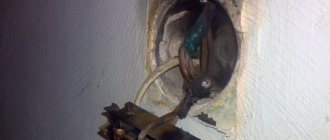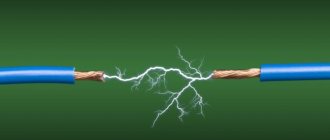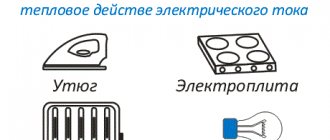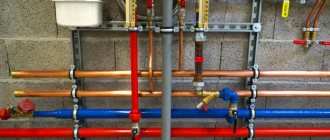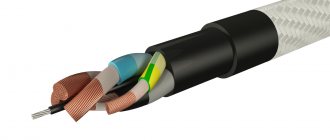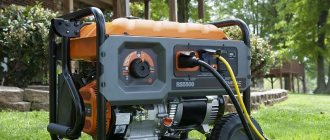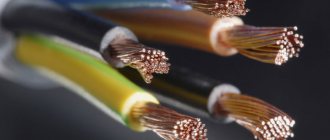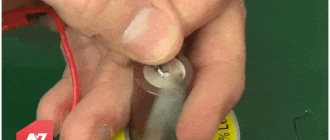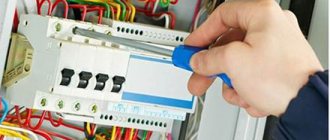Various electrical appliances and devices are widely used in production and at home. The electricity needed for their operation is delivered through electrical wiring. The source of electricity has high power, which in normal operation of the network is spent to ensure the functioning of the load (power receiver).
A short circuit of both the cable line and the internal circuits of electrical equipment is not always monitored by automatic devices. In this situation, power is released on the current transmission circuits, which is accompanied by their rapid heating with melting of the polymer insulation and ignition of electrical equipment in severe cases.
Requirements for the selection of fire extinguishers - set of rules 9.13130.2009
Code of Practice 9.13130.2009 describes the operating standards for fire extinguishing agents intended to extinguish fire in electrical equipment. This document covers the following aspects:
- basic rules for choosing stationary and mobile equipment, this also includes automatic fire extinguishing installations;
- basic instructions for the placement of selected equipment;
- indicates the pressure parameters that should be present when releasing fire extinguishing mixtures;
- indicates how often such installations should be serviced and changed.
The document also regulates the maintenance of fire extinguishers and is mandatory for reusable automatic installations.
It is important to remember that extinguishing electrical installations that are already de-energized can be done with any type of fire extinguisher.
Extinguishing live electrical installations
If the equipment is energized, then the type of fire extinguisher depends on the outgoing voltage. Powder equipment is suitable for voltages up to 1000 V. If electrical equipment has voltages up to 10,000 V and is not disconnected from the network, then a carbon dioxide fire extinguisher is required.
Extinguishing electrical equipment without voltage
Without voltage, electrical equipment can be extinguished with any type of fire extinguisher. Therefore, if possible, it is recommended to turn off the power to burning equipment or ground it. In any case, it should be remembered that some types of fire extinguishing mixtures can damage the structure or insulation. Also, some compounds cannot be used indoors.
Review of existing fire extinguishers
The industry produces a wide range of stationary and mobile fire extinguishers designed to extinguish fires in electrical equipment.
Carbon dioxide
The principle of operation of a carbon dioxide fire extinguisher (CO) is based on supplying a low-temperature composition to the area of the flame, which, due to the high speed of the gas jet, knocks down the flame and also suppresses the fire due to cooling. Using carbon dioxide technology, you can extinguish electrical wiring without leaving traces, which is attractive when operating computer, television and telecommunications equipment. Fires in electrical installations can be extinguished using carbon dioxide devices in case of class E fires, i.e. electrical equipment under voltage up to 10 thousand volts.
Carbon Dioxide Fire Extinguisher Series
The main disadvantage is the rapid drop in oxygen concentration in the room, which prevents the use of carbon dioxide technology in confined spaces.
Powder
Powder fire extinguishers, in accordance with current fire safety regulations, are compatible with installations with operating voltages up to 1 kV. It is permissible to use them even on live equipment.
The principle of operation of such devices is based on suppressing the flame by stopping the access of oxygen after supplying a neutral fire extinguishing powder to the source of fire, which covers the surface with a thin layer. It has been established that extinguishing with a special powder provides the greatest effectiveness when insulation is burning.
In addition to switchboards and electrical appliances, powder technology can be used in electric modes of transport (trolleybuses, trams), as well as in production.
The expiration date, fire extinguishing ability, as well as other data must be indicated on the body of the fire extinguisher in the form shown in Figure 1.
Rice. 1. Marking of powder fire extinguisher
Air foam
Air-foam fire extinguishers, which are represented by the ORP series, belong to rechargeable fire-fighting equipment. Designed as a portable fire extinguisher, often performed as a mobile or stationary installation. Contains a steel cylinder of various capacities filled with water-based foaming material. The functions of the expelling charge are performed by carbon dioxide, which, under high pressure, pushes the fire extinguishing agent out.
To increase the intensity of foam formation, use a metal or polymer diffuser of various shapes with a fine mesh that covers the outlet of the diffuser as shown in Fig. 2.
Rice. 2. Typical design of the sprayer of an air-foam fire extinguisher and its connection to the cylinder
To extinguish a fire, the generated powder stream is directed to the combustion site. The greatest efficiency of foam fire extinguishers is achieved when the space around the installation is completely filled.
Foam fire extinguishers are capable of extinguishing flammable liquids.
A serious drawback of this technology is that it only works at positive temperatures.
Water
Water fire extinguishers work on the principle of flooding the fire area with water. Can be used to extinguish only de-energized electrical installations. They require mandatory shutdown of the electrical installation, i.e. They are used only when there is a visible break in the power supply cable. In manufacturing, due to the risk of electrical shock, their use usually requires permission from the dispatcher.
Freon
Portable fire extinguishers with liquid hydrocarbon filler (freon) visually differ little from carbon dioxide ones. The chemical formula of refrigerant differs little from liquid fillers used in refrigeration units.
When leaving the cylinder of a freon fire extinguisher, the composition takes on the appearance of snow, covers the burning surface, cools it and at the same time cuts off the access of oxygen. Combustion stops due to the combined action of these factors.
Due to the chemical neutrality of the freon, there is no damage to the structure of electrical appliances and cables.
Modern refrigerant compounds are corrosion-neutral at room temperatures and do not destroy the ozone layer. Under the influence of a flame, freon decomposes, releasing bromine and fluorine, which are toxic to the respiratory system. Domestic and imported devices of various capacities are available for use, Fig. 3, which allows you to select the desired option.
Figure 3. Series of freon fire extinguishers of various capacities
Aerosol
Aerosol devices have two varieties, which differ in the type of filler: solid and fine powder. The extinguishing effect of these compounds is based on the fact that under the influence of high temperature an aerosol is released, which blocks the access of oxygen, for example, to burning insulation.
Examples of aerosol fire extinguishers
Aerosol fire extinguishers are characterized by:
- simplicity of design;
- operability in a wide temperature range;
- Possibility of use for extinguishing fires of all classes.
The main disadvantage is the toxicity of the aerosol, which precludes the use of this technique in enclosed spaces.
Rules for extinguishing electrical installations with a fire extinguisher
Electrical installations are dangerous equipment for many reasons. Therefore, you should know some of the nuances and rules for extinguishing such equipment using fire extinguishers.
What is the maximum voltage for electrical equipment that can be extinguished?
According to the rules, depending on the different types of fire extinguisher, the maximum voltage also changes. The indicators are:
- OP – 1000 Volts according to 5000 Volts certification;
- OU, OX - 10,000 Volts, for freon gases according to documents up to 400 Volts, but in a real fire up to 10,000;
- OVE – 1000 Volts;
- ORP, OHP - when passing tests 000 Volts.
If these restrictions are not followed, there is a risk that the fire extinguisher will not work effectively.
Closer than what distance is it not allowed to bring a fire extinguisher to a burning electrical installation?
When extinguishing electrical equipment, it is important to maintain a safe distance. Otherwise, if the equipment is live, there is a risk:
- electric arc shock;
- through a current-carrying socket or jet;
- through a static charge.
To prevent this from happening, a safe distance is regulated:
- the borderline minimum is 1 meter, regardless of voltage;
- for installations with voltage ratings up to 1000 V - 1.5 meters;
- for installations with an indicator of up to 10,000 V - 2 meters.
But experts recommend maintaining a distance of 2-3 meters, if the length of the fire extinguisher jet allows.
Which fire extinguisher should you use to extinguish electrical equipment?
In the event of a fire, the following types of fire extinguishers are used:
Powder fire extinguishers
The main indicator of the performance of a powder fire extinguisher is the correct spraying of the extinguishing agent under pressure. The mixture contains ammonium salt, sodium and potassium salt with specialized additives. As a rule, this type of fire extinguisher is used to stop any fires. When sprayed, the powder mixture covers and envelops the surface of the object. The air supply stops and the fire goes out. The use of powder fire extinguishers is permitted for class fires (A – D, see table above).
Features of extinguishing fires in electrical installations
The difficulty in extinguishing electrical installations lies in several aspects:
- fire most often occurs when equipment is exposed to current;
- not all types of fire extinguishers are suitable, especially if the fire occurs in an enclosed space and the equipment is energized;
- When extinguishing a fire, the structure of the electrical installation may be significantly damaged.
In any case, the choice of fire extinguishing agents depends on taking into account voltage parameters.
Up to 400 V
According to the above set of rules, when extinguishing electrical installations with voltages up to 400 V, you can use various methods. To minimize the risk, the following rules should be followed:
- optimal use of halon fire extinguishers;
- do not use compact jets;
- direct sprayed water towards the fire from a distance of at least 5 meters;
- It is recommended to work with dielectric gloves.
Another method is to extinguish with foam, completely filling the space around the fire.
Up to 1000 Volts
It is preferable to extinguish using powder equipment. The powder fire extinguisher is charged with a mineral salt composition, which reduces the surface temperature and stops the access of oxygen and stops the combustion process itself. At the same time, the required level of safety can only be achieved with a jet length of at least a meter.
Up to 10000 V
When extinguishing electrical equipment under such voltage, only carbon dioxide fire extinguishers can be used. Since they work with high voltage, there are requirements for certain parameters:
- moisture in the gas should not be 0.006%;
- The length of the fire extinguisher jet is at least three meters.
It is very important to disconnect equipment with such high voltage in an emergency, but this is not always possible, therefore, if there is such an installation, the enterprise must have a working carbon dioxide fire extinguisher.
Device types
The most common types of fire extinguishing agents include:
- powder fire extinguishers. The extinguishing agent in it is a special powder containing mineral salt. The principle of application is based on blocking the access of oxygen to sources of fire and reducing the temperature of burning elements due to the expenditure of the generated heat on heating the powder particles;
- air-foam fire extinguishers. The fire extinguishing agent is foam formed mechanically. Fire extinguishers of this type are often used when extinguishing fires in various hangars, warehouses, spacious in volume, and in fairly large areas;
- carbon dioxide fire extinguishers. They are a type of gas. The extinguishing agent is carbon dioxide supplied under pressure.
The advantages of carbon dioxide fire extinguishers are the low temperature of the extinguishing agent, the absence of mechanical impact on burning equipment elements, and, as a result, the absence of damage to them during fire extinguishing.
Fire extinguishers used to extinguish electrical installations differ in the type of extinguishing agent. The use of extinguishing agents of different composition and principle of action on the flame determines the areas of use of fire extinguishers of one type or another.
According to electrical safety conditions, electrical installations are of two types: voltages up to 1000 V and over 1000 V. The choice of a particular fire extinguisher is also related to the network voltage values.
Extinguishing electrical wiring
Most often, electrical wiring fires occur due to technical faults when the device does not have a protective shutdown. The most common cause is a short circuit, which can occur due to aging wiring, insulation failure or overvoltage.
First of all, you need to turn off the electricity supply. This can be done either with a simple switch or with a mechanical break using any non-conducting tool. If the wiring is de-energized, then you can extinguish it with any type of equipment, plus additionally use available means - water, sand, earth.
If it is not possible to turn off the current supply from the wiring, then extinguishing must be carried out with a powder or carbon dioxide fire extinguisher from a distance of at least a meter.
Important! You cannot extinguish wiring with foam, as there is a risk that the insulation elements will come into chemical contact with the foam composition, which will lead to subsequent failure of the entire electrical wiring.
Extinguishing electrical equipment
These are mechanisms, instruments and units that are part of the overall scheme for processing and generating electricity. These are various cable systems, uninterruptible power supplies, electrical appliances used in everyday life.
Industrial electrical equipment is most often equipped with automatic fire extinguishing devices. If there are none, then the fire should be extinguished according to generally accepted rules, and the fire extinguisher should be selected depending on the voltage of the equipment. At the enterprise, every employee must know exactly how to extinguish specific equipment and have access to the necessary fire extinguishing equipment.
Conclusion
In practice, various types of fire extinguishing installations are used. Selecting a specific type of this equipment is a multi-criteria task. When making the final decision, the following are taken into account:
- operating voltage of the protected network;
- equipment location;
- efficiency of de-energizing equipment in the event of an emergency;
- financial capabilities of the electrical equipment owner.
Regardless of the latter, human safety is always put at the forefront. The main means of achieving this are the correct selection of the type of fire extinguisher, the choice of the distance from which extinguishing is carried out, and the use of protective equipment. Regardless of the current situation, it is advisable, if possible, to first de-energize the equipment that has caught fire.
Extinguishing the electrical panel
The electrical panel room is a separate small room. There is a distribution cabinet here, which is responsible for supplying energy. The electrical panel system includes: a bus system, switches, disconnectors, and measuring instruments. According to strict rules, only personnel with a special level of clearance should be allowed to enter the electrical room.
If there is a fire in the electrical room, then first of all it is necessary to de-energize this room. Only in this case will it be possible to extinguish the fire using any available means and all available types of fire extinguishers. If the electrical panel remains energized, you will have to choose a carbon dioxide fire extinguisher.
Attention! Even a de-energized electrical panel should not be extinguished with water, as this will lead to a negative impact on the operation of all equipment.
Extinguishing any live equipment is much more difficult. Therefore, in enterprises with a large amount of electrical equipment, it is necessary to have several types of fire extinguishers, including powder and carbon dioxide. The latter is suitable for extinguishing equipment with voltages up to 10,000 Volts, even if such an installation is not disconnected from the power supply. It is important to carry out extinguishing in accordance with all safety rules and maintain a distance of at least a meter from the point of fire. The best option is 2-3 meters.
Operational action plan in case of electrical installation fire
In the event of a fire, it is important that employees do not panic and follow all established safety rules. Specialists are trained in fire extinguishing methods in courses.
The emergency procedures and procedures are as follows:
- the employee who noticed the ignition is obliged to report this to management;
- the shift supervisor informs the fire services and all employees of the enterprise;
- then evacuation is carried out and the automatic fire extinguishing system is turned on;
- the shift supervisor meets the rescuers and escorts them to the fire site;
- At the request of the fire service, the electricity is turned off.
Attention! The technological document “Tactics for extinguishing electrical installations under voltage” must be located in an accessible place at the enterprise so that all employees can read the instructions. possible on our website. The network also offers videos of fire extinguishing on electrical installations.
Table - Permissible distances from electrical installations to fire nozzle nozzles.
| Electrical installation voltage, kV | Distance from the fire nozzle nozzle to the burning electrical installation and cable, m |
| up to 1 | 4 |
| 1–10 | 6 |
| 10–35 | 8 |
| 35–110 | 10 |
By the way. Electrical appliances can ignite at enterprises of various types (mechanical engineering, metallurgy, boiler houses). Inventory and equipment stored in these organizations are often explosive.
